The visit to the Viking site at L’Anse aux Meadows, was a highlight of our trip to Newfoundland. Our guide, local resident Kayla, was educated as a folklorist, which means she was trained to tell stories. These were informative. We certainly gained a better understanding of the Viking settlement there. Lots of talk about the use of bog iron to make iron. In a reconstructed viking house, we also met a freeman who was doing wood working, and a freewoman who was weaving. Both of them should be happy that they did not need to rely on their crafts to support themselves!
There is a Norwegian connection that begins with Helge Ingstad. He is one of few people who have lived in three different centuries. He was born in 1899-12-30 in Meråker and died 2001-03-29 in Oslo. Meråker is in Trøndelag county where we live, but perhaps 100 km further south, and adjacent to Sweden. Helge was educated as a lawyer, and had a practice in Levanger, about 50 km further south from Cliff Cottage. In 1926 he explored the wilderness of Canada, working at times as a fur trader, before becoming the Governor of Norwegian territories on Greenland, then Svalbard = Spitsbergen.
In Svalbard he met Anne Stine Moe (1918-1997). They married in 1941. In 1946, they moved to the Holmenkollen area of Oslo, where they lived when not travelling the world. Anne Stine was an archaeologist. The couple also began to go through saga texts and archaeological material from the northern regions, where they came across a hypothesis put forward by the Swedish philologist Sven Söderberg (1928 – 2004), that the prefix -vín in Vinland did not necessarily have to do with wine, but rather with the old Norse language vín in the sense of meadow, field, grassland, as in the old name for Bergen, Bjørgvin.
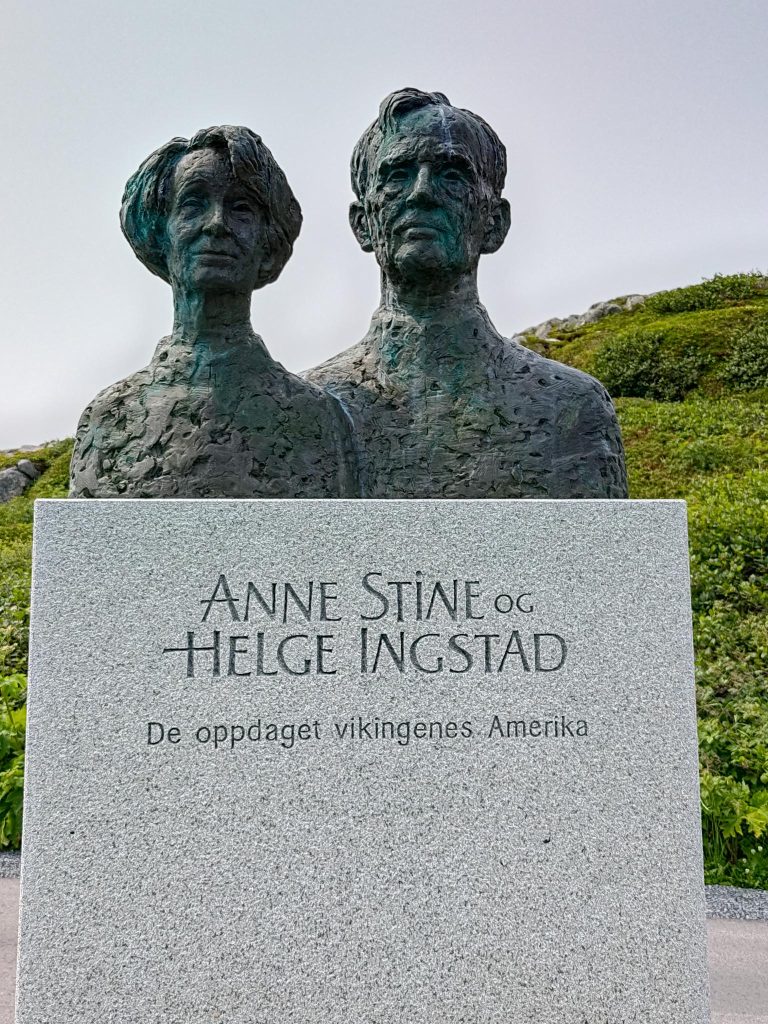
Between 1961 and 1968, the Ingstads discovered settlement traces at L’Anse aux Meadows, that turned out to be Nordic from the Viking period. Folklorist Kayla thought that the reason why the Ingstads managed to discover them had to do with Helge’s personality. People did not view him as an aloof academic or professional, but an ordinary person local residents could relate to. He established rapport with the people he spoke to, before asking questions. This meant he received honest replies. His questions often had to do with humps and bumps in the local landscape that could conceal an archaeological site! When he asked local resident George Decker that question, he was shown L’Anse aux Meadows!

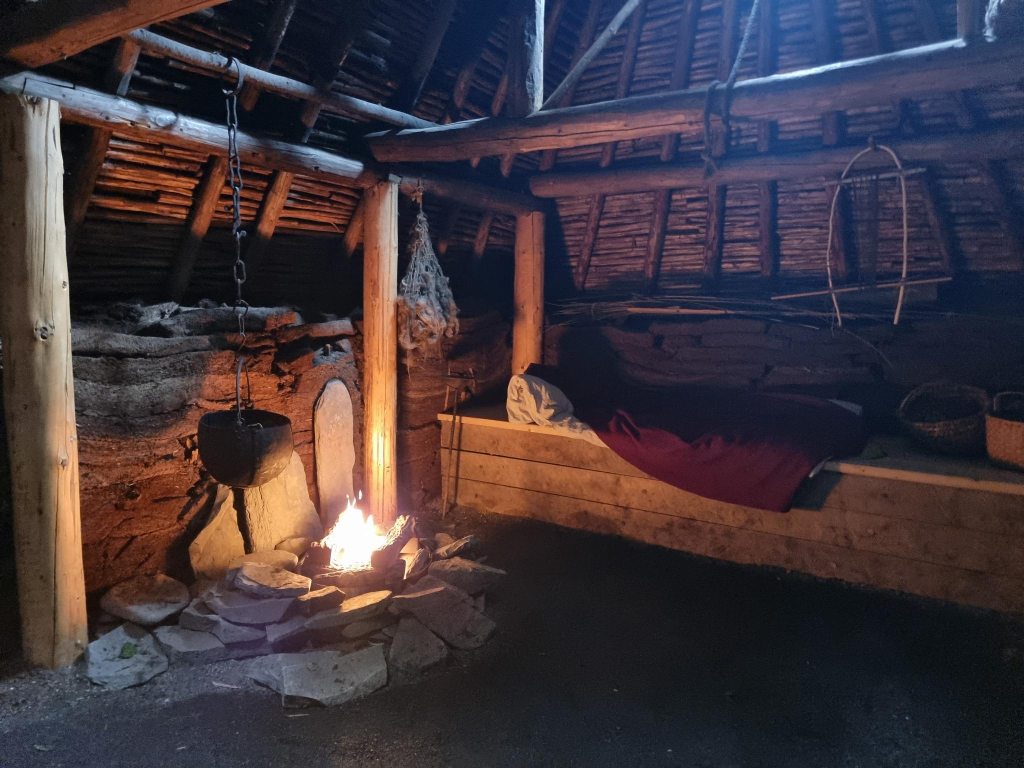
L’Anse aux Meadows was not located in Vinland. That was further south, possibly in New Brunswick. L’Anse aux Meadows was a boat repair centre, sometimes referred to as a pit stop, used seasonally. After about one generation of use, valuable possessions were removed from the settlement, and what remained was deliberately destroyed.
“Anne Stine and Helge Ingstad, they discovered the Viking’s America.” This is the Norwegian inscription on the sculpture at the entrance of L’Anse aux Meadows visitor centre, made by Inderøy sculptor Nils Aas, who was raised in Straumen, 13 km from Cliff Cottage. The sculpture was given by the people of Norway to the people of Canada in 2001, mediated by the Norwegian king Harald, after Helge Ingstad’s death.
Sandra (1943 – ), one of the visitors, was having some difficulty walking, so I slowly walked with her through the site, while the young people walked quickly on, but had to wait for us to catch up. Little at the site is a thousand years old. Luben Boykov (1960 – ) and Richard Brixel (1943 – 2019) created each their half of The Meeting of Two Worlds, unveiled 2002-07-06. The sculpture symbolizes the suspected meeting of the Norse and the Indigenous peoples of North America
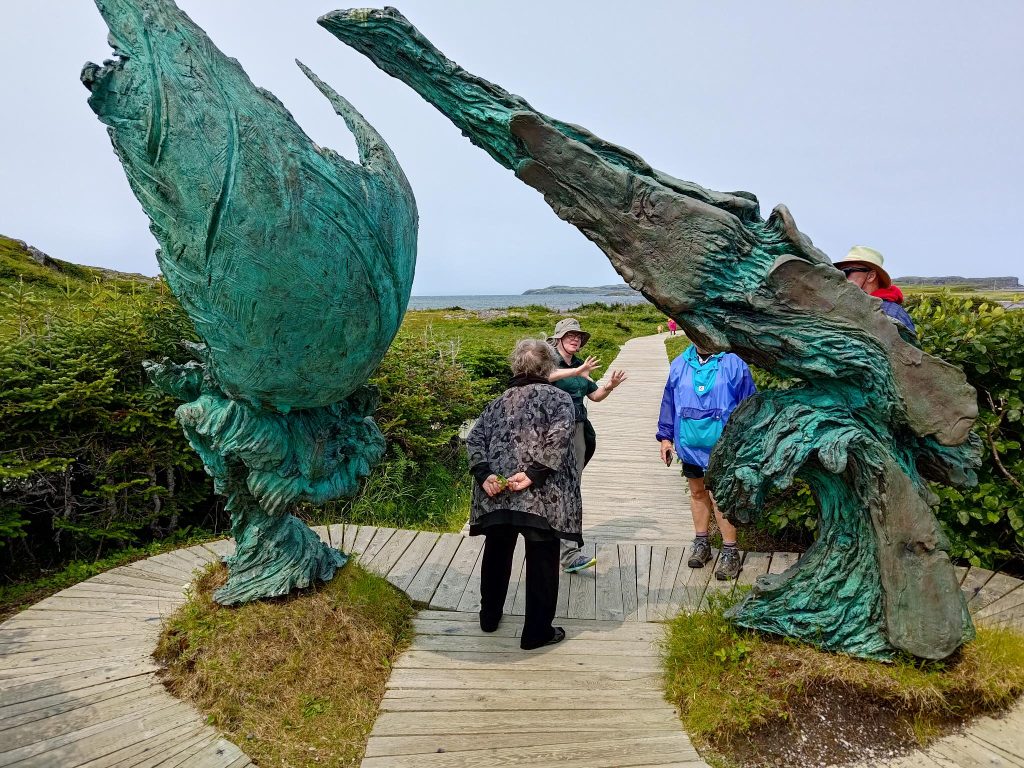
YAY
Of course we visit airports when given an opportunity. On the Great Northern Peninsula, YAY airport is located at St. Anthony. We visited it on our way to L’Anse aux Meadows. There are about eight scheduled flights a week: five involve YXB at Blanc-Sablon, Quebec; three YYT at St. John’s.
After entering the airport, we (as in Alasdair) were able to take a lot of photographs without having to disturb or be disturbed by passengers. The security guard was unperturbed by our presence.
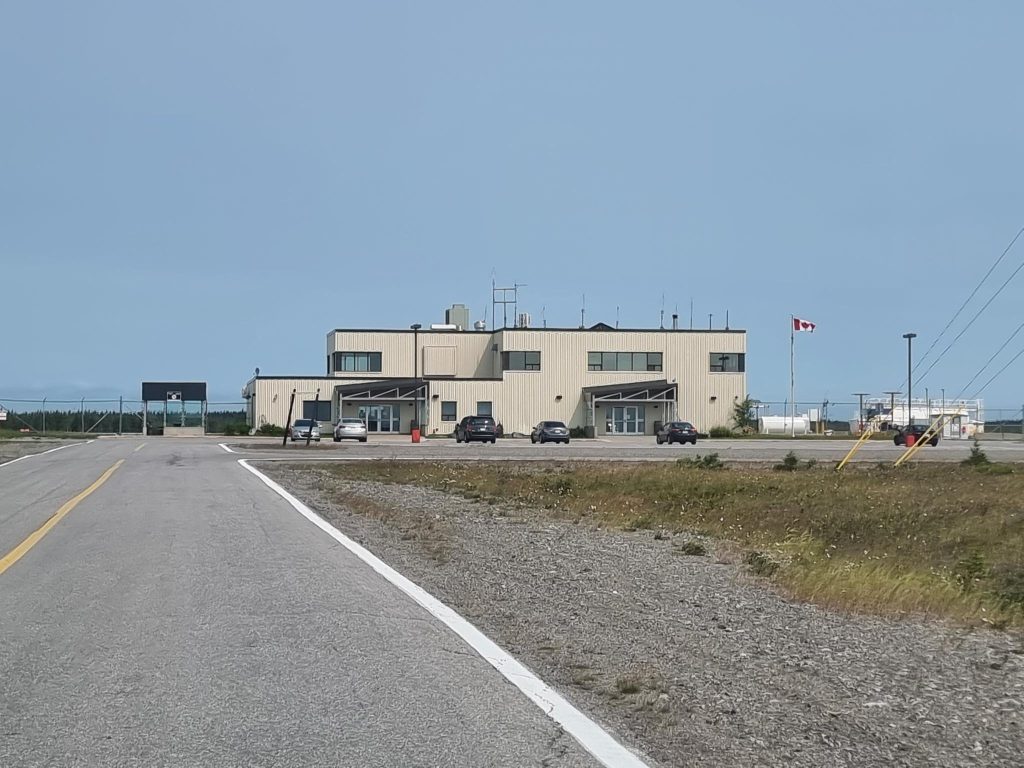
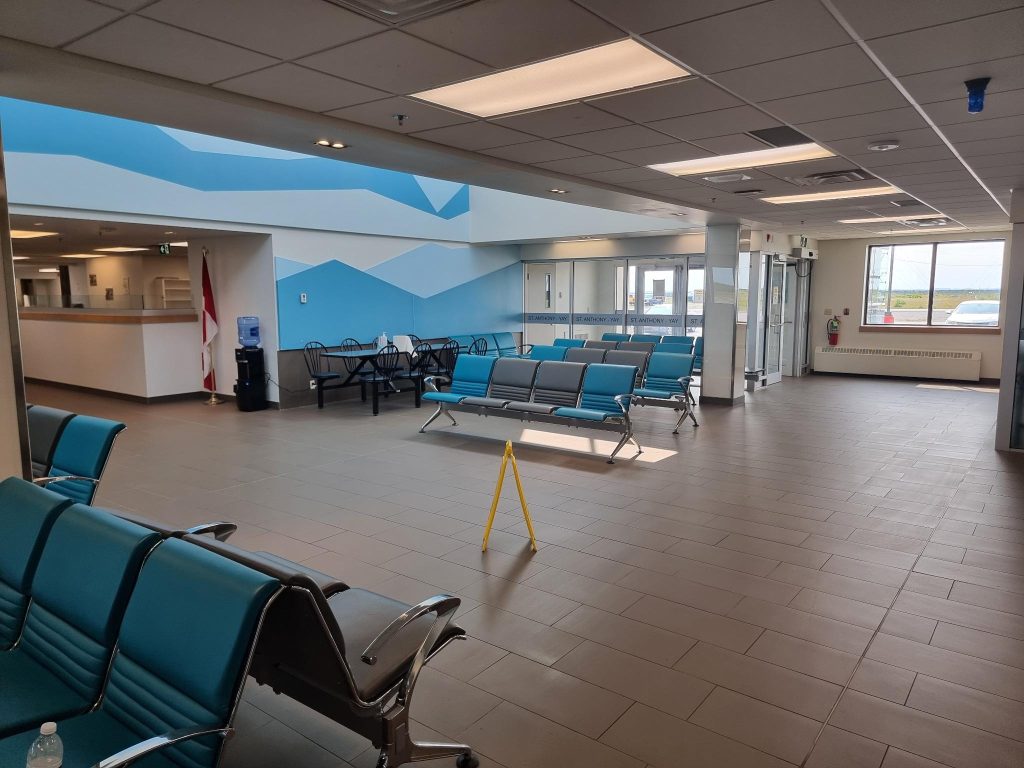
Meanwhile back at the Genevieve Bay Inn
I talked to Wilfred Doyle, who – with his wife Donna – owns the Genevieve Bay Inn where we stayed. Wilfred’s area of responsibility is maintenance, as well as Thirsty’s Lounge = the largest bar in Newfoundland, opened 2003-12-31. Donna seems to be in charge of everything else. At the inn, most rooms are fitted with two home-made double bunk beds, to accommodate eight. These are family rooms. Not everyone is expected to share a bed with someone. I complimented Wilfred on the use of Robertson screws in the beds he made. He admitted, he prefers to use Robertson, but will use Torx if there is nothing else.
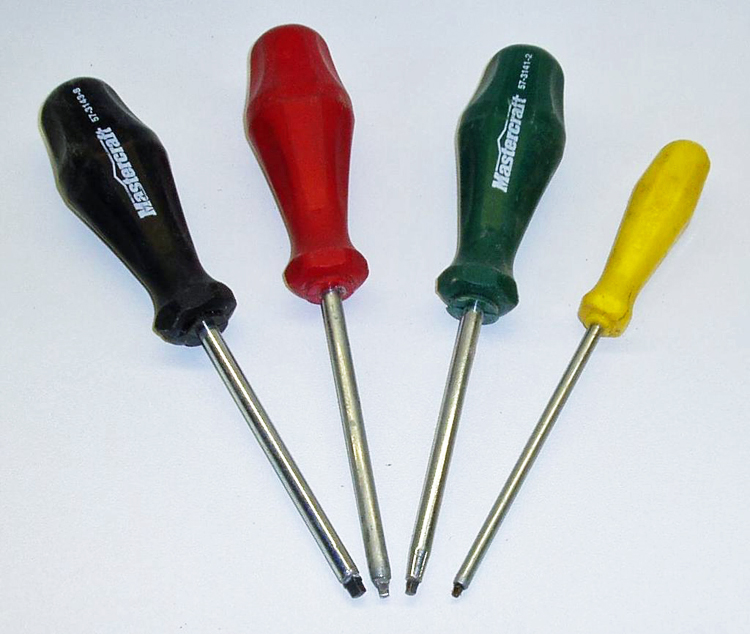
One of the guests had hit a Moose on the highway with his smallish Toyota. All the passengers (including his two younger children) had survived without injury. We talked about this, snow, studded snow tires and moose hunting.
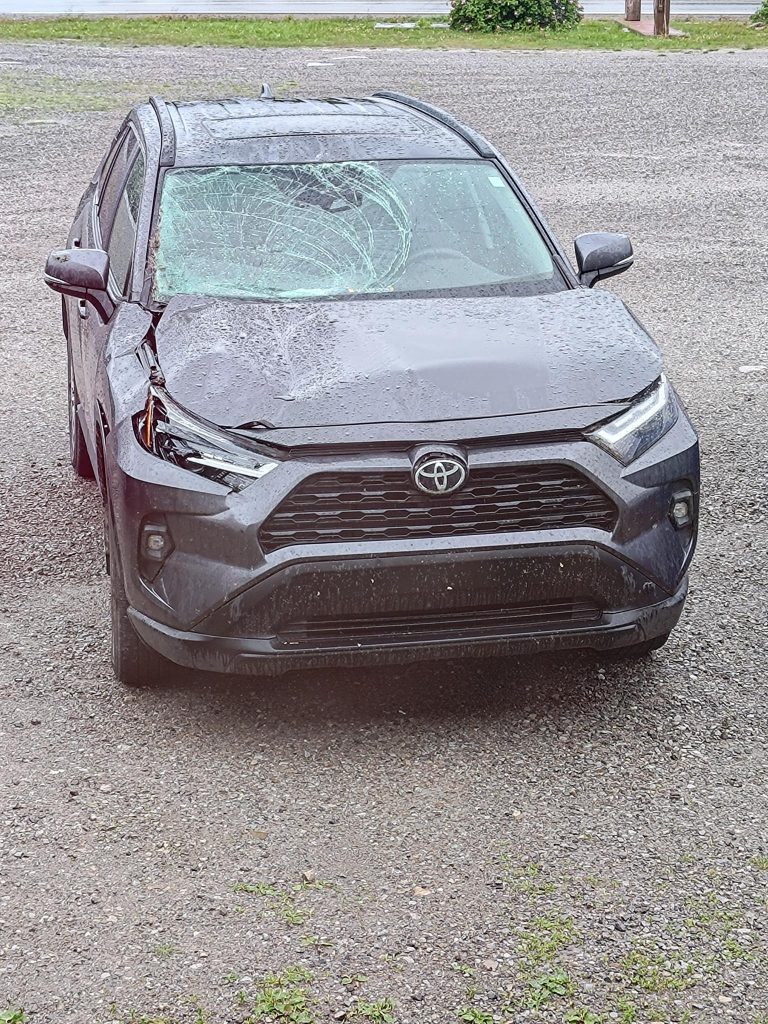
Wilfred says that there is less snow now than previously, so he changes his “tires and rims” close to the end of November, then back again, some time in April. He is an active moose hunter. Which means he watches the moose from inside the Inn. When one is coming through, he gets his rifle, goes outside and shoots it. This is not hunting for sport, but food, possibly the difference between survival and starvation, a century before.


Helsing frå Verdens navle on søre Sotra.
Don’t rely wholly on a spell checker, (especially if it is in an Apple phone).
Take the word coupling when writing of furniture and Robertson screw heads. I presume you wrote ‘complemented Wilfred’ but this was changed by a dæmon into the published word!
I inherited some Robertson screws and a couple of drivers, from an uncle. The drivers have wooden handles so they are of a different vintage to those in your picture. These screw slots are better than straight ones, of course, and compete with Pozidriv.
They are far superior to the nasty Philips or PK slot that are used in so many places now.
L’anse Aux Meadows is one of the places on my ‘bucket list’.
Yes, Peter, I too had 3 wooden handled Robertson screwdrivers in my youth. They were green, red and black. I used them when making my 8 foot Sabot dinghy. It was claimed that they were useful for working in cramped quarters that necessitated a one-handed movement.
I have now gone modern, and use Torx screws. In part it is because I can’t find Robertson screws in Norway. In part, it is because Torx are better screws. When inferior screws, such as slotted, pozidrive or Phillips, enter the house (usually accompanying other components) they are immediately recycled.
For woodworking I have my own standard sizes, where possible Heco brand in corrosion protection class 4, for both indoor and outdoor use. The smallest length I use is 15 mm, followed by 20, 30, 40, 60, 90, 120 and 160 mm. Sometimes, I can’t get 90 mm so I have to substitute 80 mm.